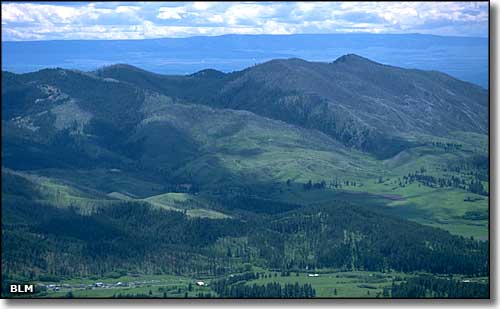 |
Lewis and Clark National Forest |
 In the Judith Mountains |
|
Elevations across the Lewis & Clark National Forest vary from a low of about 4,500' to a high of 9,362' at the summit of Rocky Mountain Peak. The Forest is within the upper Missouri River system in central and north central Montana. More than 380,000 acres of the Forest are contained within the Bob Marshall-Great Bear-Scapegoat Wilderness Complex. There are two other congressionally designated Wilderness Study Areas on the forest, one in the Little Belt Mountains and the other in the Big Snowy Mountains. Another 10,730 acres in the Forest are contained within various designated Research Natural Areas. There are about 1,600 miles of perennial streams flowing in the Lewis & Clark National Forest but there are only a few small natural and man-made lakes on the forest. One stream is the Smith River, a nationally acclaimed blue ribbon trout stream with more than 20 miles of frontage on the Lewis & Clark. More than 60 streams have been shown to support populations of westslope cutthroat trout, an imperiled fish native to the Upper Missouri Basin. The Lewis & Clark National Forest Headquarters is in Great Falls with local ranger district offices in Harlowton, Choteau, Stanford, White Sulphur Springs and Neihart. Among the seven mountain ranges that are part of the Forest are the Judith, Big Snowy, Castle, Crazy, Little Snowy, Highwood and Little Belt Mountains. There are more than 1,500 miles of hiking and horseback riding trails on the Forest. You'll usually find the least people in the Crazy Mountains and in the wilderness areas along the Continental Divide. In the more exposed east-facing areas of the high mountains, snow can linger well into July. |
|
|
 |
| Index - Arizona - Colorado - Idaho - Montana - Nevada - New Mexico - Utah - Wyoming National Forests - National Parks - Scenic Byways - Ski & Snowboard Areas - BLM Sites Wilderness Areas - National Wildlife Refuges - National Trails - Rural Life Advertise With Us - About This Site - Privacy Policy |
| Photo of the Judith Mountains courtesy of the Bureau of Land Management. Text Copyright © by Sangres.com. All rights reserved. |